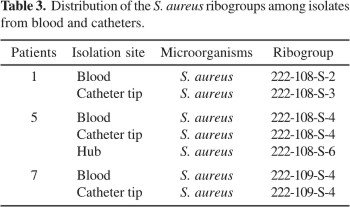Biofilm bacterial infections are common in patients undergoing treatment with haemodialysis. This study involved 16 patients (7 males, 9 females; ages from 22 to 81 with an average age of 50) who had had a total of 25 temporary haemodialysis polyurethane catheter insertions into the subclavian vein (22 dual-lumen and 3 triple-lumen). The catheters remained in place from 3 to 91 days, on an average of 47 days. The reasons for catheter removal were: bad functioning (44%), suspicion of catheter-related infection (20%), availability of permanent access (16%), accidental removal (12%), signs and symptoms of infection at the site of catheter insertion (4%), and exogenous contamination (4%). Positive tip cultures were observed on seven of the catheters (28%), showing three positive blood cultures. The Staphylococcus aureus were identified in 12% of the blood cultures and isolated from one of the hubs, and biofilms were observed on all catheter tips. The S. aureus retrieved from both blood and catheters (tips and hubs) were resistant to penicillin and susceptible to azithromycin, ciprofloxacin, clindamycin, chloramphenicol, gentamicin, oxacillin, rifampin, sulfamethoxazole, tetracycline, and vancomycin. The S. aureus strains isolated from both blood and catheters (tips and hubs) were considered to be identical based on antibiotic susceptibility patterns and genetic similarity assessed using an automated ribotyping system.
biofilm; catheter in haemodialysis; central venous catheter; catheter-related infections




